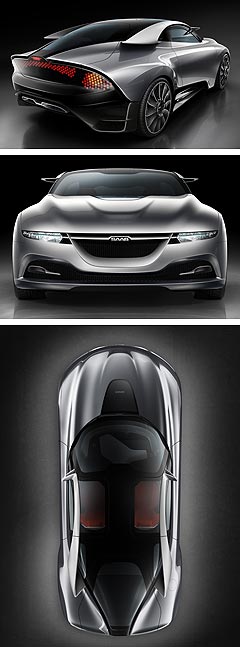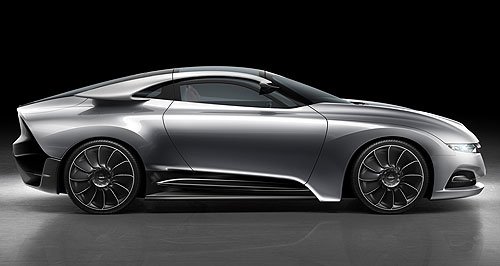Future models - Saab - PhoeniXGeneva show: Saab's PhoeniX rises from the ashesPhoeniX: Swedish car-maker Saab has emerged from the ashes with this sports coupe concept. Saab celebrates end of a dark era with a daring concept looking to the future2 Mar 2011 By RON HAMMERTON in GENEVA THE motor company that was on its knees and in danger of liquidation a year ago, Saab Automobile, pulled one of the biggest surprises at this week's Geneva motor show when it revealed the aptly named PhoeniX sports coupe design study, based on an all-new flexible platform that is set to spawn a whole range of future Saab cars. The eye-catching tear-drop design by former Ferrari stylist Jason Castriota – now Saab Automobile’s executive design director – not only symbolises Saab's rise from the ashes to a secure future but to also reflects the Swedish company's rich history. The design went from an a suggestion by Saab chairman Victor Muller – the former head of Spyker Cars who negotiated the purchase of the brand from General Motors to keep it from the scrap heap – to a fully-fledged show car in a matter of months. It arrived under a cloak of secrecy at the Swiss show just days after Saab and its workers at Trolhattan, Sweden, celebrated 'Independence Day' – the 12-month anniversary of the Spyker deal to acquire the brand and assets of Saab in February, 2010. While the Saab media release said the PhoeniX's architecture would “empower the next Saab 9-3”, Saab CEO Jan Ake Jonsson revealed to GoAuto that the platform would also provide the basis for other models, such as the second-generation 9-4X and even the next version of the company's flagship 9-5.  As well, the design language of the PhoeniX is expected to make its way in those new models, which will include a sports coupe if designer Mr Castriota gets his way. As well, the design language of the PhoeniX is expected to make its way in those new models, which will include a sports coupe if designer Mr Castriota gets his way.“I would like to make something like that,” the American stylist said after his boss Mr Muller pulled the covers from the two-door concept. Before the show, Saab had announced it was to reveal the 9-5 wagon on its stand, but as journalists and photographers crowded around the stage, it was clear that something a little more svelte was parked under the satin sheet. Saab describes the PhoeniX's design as ‘Aeromotional’, saying it was inspired by Saab’s aviation roots. It says the teardrop shape also honours Saab’s first car, the Ursaab, while the glasshouse is supposed to resemble a jet fighter's canopy – another link to Saab's more modern aviation history. “The clean, muscular shape enables an exceptionally low drag co-efficient of just 0.25 and also explores the potential for airflow management through the use of distinctive, side-mounted ‘winglets’,” Saab says. Those winglets on the car's C-pillars were also described as 'flying buttresses' by Mr Castriota, who divides his time between his home in New York and Saab's headquarters as Trollhattan. One of the most arresting features of the PhoeniX, the winglets are said to channel airflow from the side of the car and direct it across the rear deck, reducing lift without increasing drag. “The PhoeniX establishes a new reference point for the future of Saab product design,” Mr Castriota said. “It symbolises a renaissance of the innovative spirit and passion that drove Saab to build its first car. “We’re now taking the visual DNA forward with what we call ‘aeromotional’ design, adding emotion, power and fluidity. This design aesthetic will shape and differentiate future models in the Saab portfolio.” Scissor-style doors – described by Saab as buttefly doors – open to reveal a 2+2 layout with minimalist treatment in the Swedish style, although the instruments are housed in a binnacle that is said to have been inspired by a jet afterburner. In show guise, the PhoeniX has a hybrid driveline, mixing an electrically-driven rear axle mated to a sophisticated 1.6-litre turbo-charged petrol engine. This is hooked up with a manual gearbox and Saab's new eXWD all-wheel-drive system that has a rear-mounted 25kW electric motor/generator powered by a small battery pack charged by regenerative braking. Saab says this system is under development for the next generation of Saab cars, offering the benefits of all-wheel drive while reducing fuel consumption to a projected combined cycle fuel economy of 5.0 l/100km. CO2 emissions are said to be 119 g/km. Saab describes the PhoeniX's iQon infortainment system as ground-breaking, using Google's Android operating system to seamlessly connect to the internet when the car’s ignition is switched on. A touch-screen provides access to audio and entertainment streaming, online navigation, on-board music storage and smartphone-like downloading of applications.  Read moreAll motor show Alfa Romeo Alfa Romeo Abarth Abarth Alpine Alpine Alpina Alpina Audi Audi Aston Martin Aston Martin BMW BMW Bentley Bentley Chery Chery Brabham Brabham Chrysler Chrysler Chevrolet Chevrolet Cupra Cupra Citroen Citroen DS DS Dodge Dodge Fiat Fiat Ferrari Ferrari Foton Foton Ford Ford Great Wall Great Wall FPV FPV Haval Haval GWM GWM Honda Honda Holden Holden Hummer Hummer HSV HSV Infiniti Infiniti Hyundai Hyundai Jaguar Jaguar Isuzu Isuzu Kia Kia Jeep Jeep Land Rover Land Rover Lamborghini Lamborghini Lexus Lexus LDV LDV Mahindra Mahindra Lotus Lotus Mazda Mazda Maserati Maserati Mercedes-AMG Mercedes-AMG McLaren McLaren MG MG Mercedes-Benz Mercedes-Benz Mitsubishi Mitsubishi Mini Mini Opel Opel Nissan Nissan Peugeot Peugeot Pagani Pagani Proton Proton Porsche Porsche Renault Renault Ram Ram Rover Rover Rolls-Royce Rolls-Royce Skoda Skoda Saab Saab SsangYong SsangYong Smart Smart Suzuki Suzuki Subaru Subaru Toyota Toyota Tesla Tesla Volvo VolvoMotor industry news |
Click to shareAll motor show Alfa Romeo Alfa Romeo Abarth Abarth Alpine Alpine Alpina Alpina Audi Audi Aston Martin Aston Martin BMW BMW Bentley Bentley Chery Chery Brabham Brabham Chrysler Chrysler Chevrolet Chevrolet Cupra Cupra Citroen Citroen DS DS Dodge Dodge Fiat Fiat Ferrari Ferrari Foton Foton Ford Ford Great Wall Great Wall FPV FPV Haval Haval GWM GWM Honda Honda Holden Holden Hummer Hummer HSV HSV Infiniti Infiniti Hyundai Hyundai Jaguar Jaguar Isuzu Isuzu Kia Kia Jeep Jeep Land Rover Land Rover Lamborghini Lamborghini Lexus Lexus LDV LDV Mahindra Mahindra Lotus Lotus Mazda Mazda Maserati Maserati Mercedes-AMG Mercedes-AMG McLaren McLaren MG MG Mercedes-Benz Mercedes-Benz Mitsubishi Mitsubishi Mini Mini Opel Opel Nissan Nissan Peugeot Peugeot Pagani Pagani Proton Proton Porsche Porsche Renault Renault Ram Ram Rover Rover Rolls-Royce Rolls-Royce Skoda Skoda Saab Saab SsangYong SsangYong Smart Smart Suzuki Suzuki Subaru Subaru Toyota Toyota Tesla Tesla Volvo VolvoMotor industry news |















Facebook Twitter Instagram